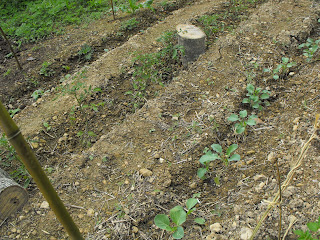It feels like England right now. Outside, it's cool and breezy, not to get above 75 degrees for the day. It rained a bit yesterday and the day before, and the weatherman tells me that it will rain in the upcoming days as well. Rain, rain, rain. I love it. The more soft gentle rains we get the more the groundwater will be replenished. We are managing to get the garden planted in spite of all this rain. The one thing the rain makes difficult is the continuation of our drought gardening practices.
"Why" you might ask "are you bothering with drought gardening when you are getting all this rain?" Well, I'll tell you.
We live on the top of a big hill. At the bottom of the hill is a nice creek that has decent flow year round. We make such good use of this creek through the hot dry Tennessee summers: swimming, bathing, resting in the cool shade, and occasionally rinsing a bit of clothing. But, the steep road, which is often nearly too washed out for driving, would be an arduous trek with five gallon pails of water. We have no well on our land and rely solely on our rain barrels for water.
What this means is that when the rain stops (and around here it is sure to) we are very limited in what we can do to keep our plants alive. Some crops do not seem to mind this overmuch. Row crops like beans and cowpeas manage fairly well if they've had adequate moisture in their childhoods, as does corn. But in our experience, the intense mid summer Tennessee heat will absolutely burn tomato plants alive! And that is why, in spite of the English style rains we are experiencing right now we continue to plant tomatoes, peppers, and eggplants along with many other plants, in deep depressions in the ground so that rain that falls on them will be focused to their roots instead of spreading out over the ground surface.
Some are being planted in trenches, for the same reason and also because the trenches help stem the rapid downhill flow of water from the sudden toad-floater storms of summer.
And last but surely not least, mulch. A layer of paper or cardboard with thick layer of hay or straw on top makes for a wonderful, moisture retaining sponge that also keeps down the weeds! (Weeds steal a lot of moisture from the plants we need for our food.)
It would be so much easier and faster for us to put in plants in the spring if we could only make ourselves believe that drought gardening is not necessary. The rain right now is tempting us to do just that. But years after years of burnt tomato plants up on this hot dry hill assure us that we are doing the right thing. And if it rains nicely all summer? The only thing we might need to do is pull back some of the mulch to avoid mold problems. Not a bad deal.





No comments:
Post a Comment